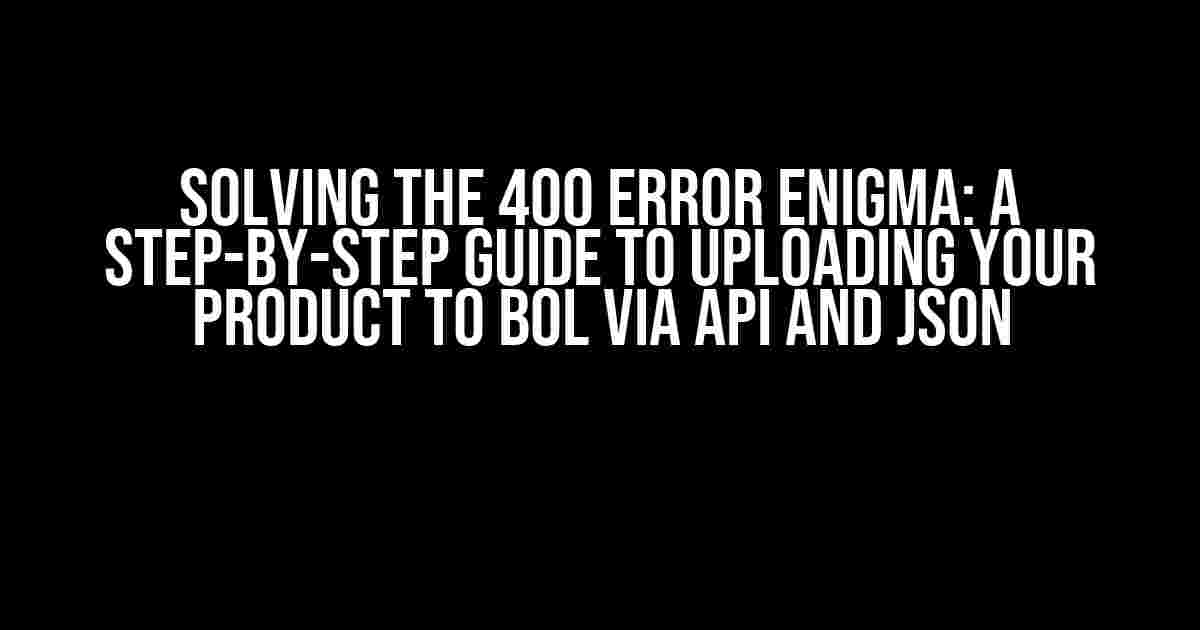The Quest for Successful Product Uploads
Are you tired of hitting a roadblock every time you try to upload your product to Bol using their API and JSON? Do the elusive 400 error messages haunt your dreams, leaving you scratching your head and wondering what went wrong? Worry no more, dear reader, for we’re about to embark on a thrilling adventure to conquer the 400 error beast and emerge victorious!
Understanding the 400 Error
A 400 error, also known as a “Bad Request” error, occurs when the server cannot process the request sent by your API due to invalid or malformed data. It’s like trying to fit a square peg into a round hole – it just won’t work! In our case, the square peg is the JSON data, and the round hole is Bol’s API.
Common Causes of 400 Errors
- Invalid or missing API key
- Mismatched data types or formats
- Incorrectly structured JSON data
- Incomplete or missing mandatory fields
- Authorized IP ranges not configured
Step 1: Verify Your API Key and Credentials
Before we dive into the world of JSON, ensure you have a valid API key and credentials. Log in to your Bol account and navigate to the “API” section. If you haven’t already, generate a new API key or update your existing one to match the required format.
API Key Format: xxxxxxxx-xxxx-xxxx-xxxx-xxxxxxxxxxxxStep 2: Prepare Your JSON Data
Now that we’ve got our API key in check, it’s time to craft our JSON data. Bol requires a specific structure and format for their API, so we’ll need to follow their guidelines to avoid those pesky 400 errors.
{
"products": [
{
"ean": "9781234567890",
"title": "Sample Product Title",
"description": "This is a sample product description.",
"price": 19.99,
"stock": 100,
"weight": 500,
"dimensions": {
"length": 20,
"width": 15,
"height": 10
},
"images": [
"https://example.com/image1.jpg",
"https://example.com/image2.jpg"
]
}
]
}
Step 3: Configure Your API Request
Next, we’ll set up our API request using your preferred programming language or tool. Make sure to:
- Set the `Content-Type` header to `application/json`
- Use the `POST` method for creating new products
- Specify the `https://api.bol.com/api/v2/products` endpoint
- Include your API key in the `Authorization` header
curl -X POST \
https://api.bol.com/api/v2/products \
-H 'Authorization: Bearer YOUR_API_KEY' \
-H 'Content-Type: application/json' \
-d '{
"products": [...]
}'
Step 4: Test and Debug Your API Request
It’s time to put our API request to the test! Use tools like Postman or cURL to send the request and inspect the response. If you encounter a 400 error, don’t panic! Check the error message and response body for clues about what went wrong.
HTTP/1.1 400 Bad Request
Content-Type: application/json
{
"errors": [
{
"code": "invalid_request",
"message": "Invalid product data",
"field": "products.0.ean"
}
]
}
Common 400 Error Scenarios and Solutions
| Error Code | Error Message | Solution |
|---|---|---|
| invalid_request | Invalid product data | Verify JSON structure and data types |
| missing_field | Missing required field ‘title’ | Ensure all mandatory fields are present |
| invalid_image_url | Invalid image URL format | Check image URL syntax and formatting |
Conclusion
By following these steps and troubleshooting common 400 error scenarios, you should be well on your way to successfully uploading your product to Bol via API and JSON. Remember to stay calm, patient, and meticulous in your approach, and always refer to Bol’s API documentation for the latest guidelines and requirements.
With persistence and practice, you’ll conquer the 400 error enigma and become a master of Bol’s API. Happy uploading!
Frequently Asked Questions
Stuck with uploading your product to Bol via API and JSON? Don’t worry, we’ve got you covered!
What does a 400 error mean when uploading my product to Bol via API and JSON?
A 400 error typically indicates that there’s an issue with the request you’re sending to Bol’s API. This could be due to invalid or malformed data, incorrect API credentials, or even a typo in your API endpoint URL. Double-check your request and API credentials to ensure everything is correct and try again!
Is my JSON data correctly formatted for Bol’s API?
Make sure your JSON data is properly formatted and adheres to Bol’s API specifications. Check for any syntax errors, incorrect data types, and ensure that you’re using the correct encoding (UTF-8). You can use online tools like JSONLint or JSLint to validate your JSON data. If you’re still unsure, refer to Bol’s API documentation for more information!
Do I need to authenticate my API request to upload products to Bol?
Yes, you’ll need to authenticate your API request to upload products to Bol. You can do this by including your API credentials (username and password) or API key in the request headers. Make sure you’re using the correct authentication method and credentials, as specified in Bol’s API documentation. This will ensure that your request is authorized and processed correctly!
What are the required fields for uploading a product to Bol via API and JSON?
Check Bol’s API documentation for the required fields and data types for uploading a product. Typically, you’ll need to provide product information such as title, description, price, image URLs, and more. Ensure that you’re including all the required fields and formatting them correctly to avoid any errors. If you’re unsure, you can always contact Bol’s support team for more information!
Where can I find more information about Bol’s API and troubleshooting 400 errors?
Head over to Bol’s API documentation and developer portal for more information on their API endpoints, request formats, and error handling. You can also search for online forums, communities, and support resources where developers and users share their experiences and solutions. Additionally, don’t hesitate to reach out to Bol’s support team for direct assistance and guidance!
